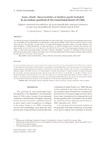Please use this identifier to cite or link to this item:
https://accedacris.ulpgc.es/handle/10553/75577
| Title: | Some abiotic characteristics of shallow ponds included in an Andean peatland of the transitional desert of Chile | Other Titles: | Algunas características abióticas de pozas superficiales interiores presentes en una vega altoandina del desierto transicional de Chile | Authors: | Cepeda-Pizarro, J. Armijo L., Alfonso A. Pérez Báez, Sebastián Ovidio |
UNESCO Clasification: | 250806 Hidrografía | Keywords: | Andean Hydrochemistry Andean Wetlands Desert Ponds Saline Ponds Temporary Ponds |
Issue Date: | 2015 | Journal: | Idesia | Abstract: | The study ponds are part of a peatland located in the Elqui river basin of the Andes. They turned out to be heliotropic (homoeothermic), mesotrophic and mesopoikilohaline microlimnotopes. The ponds showed high content of dissolved metals, mainly Ca (mean ~205 mg/l), Na (~60 mg/l), Mg (~60 mg/l) and K (~13 mg/l), and the inorganic non-metals sulfate (~976 mg/l), chloride (~34.2 mg/l), phosphate (~23 mg/l), bicarbonate (~11 mg/l) and nitrate (~3.3 mg/l). Excluding Hg, Se and nitrite, trace elements were represented by Al, As, Cd, CN, Cu, Cr, Fe, Ba, Be, Co, Zn, Mo, Ni, Pb, Li, Ag, and V. The cationic pattern of ponds was Ca > Na > Mg > K >Mn; whereas the anionic pattern was sulfate > chloride > phosphate > carbonate > Fl. Although we did not study, the hydrochemical characteristics of these water bodies seem to reflect the characteristics of the geological substrate of the mountains through which the water drains into the peatland. Las pozas estudiadas forman parte de una vega ubicada en el piso altoandino de la hoya hidrográfica del río Elqui. Estas resultaron ser microlimnotopos heliotópicos (homeotérmicos), mesotróficos y mesopoikilohalinos. Las pozas mostraron niveles elevados de metales disueltos, principalmente Ca (promedio: ~205 mg/l), Na (~60 mg/l), Mg (~60 mg/l) y K (~13 mg/l), y los inorgánicos no metálicos sulfato (~976 mg/l), cloruro (~34,2 mg/l), fosfato (~23 mg/l), bicarbonato mg/l) y nitrato (~3,3 mg/l). Excluyendo Hg, Se y nitrito, las pozas presentaron niveles traza de Al, As total, Cd, CN, Cu, Cr, Fe, Ba, Be, Co, Zn, Mo, Ni, Pb, Li, Ag y V. El patrón catiónico de las pozas fue Ca > Na > Mg > K > Mn; a su vez, el patrón aniónico fue sulfato > cloruro > fosfato > carbonato > Fl. Aunque no fue estudiado por nosotros, las características hidroquímicas de estos cuerpos de agua parecen reflejar las características del sustrato geológico de las montañas por medio del que el agua fluye hacia la vega. |
URI: | https://accedacris.ulpgc.es/handle/10553/75577 | ISSN: | 0073-4675 | DOI: | 10.4067/S0718-34292015000300002 | Source: | Idesia [ISSN 0073-4675], v. 33 (3), p. 9-15, (Enero 2015) |
| Appears in Collections: | Artículos |
Page view(s)
111
checked on Dec 14, 2024
Download(s)
83
checked on Dec 14, 2024
Google ScholarTM
Check
Altmetric
Share
Export metadata
Items in accedaCRIS are protected by copyright, with all rights reserved, unless otherwise indicated.
